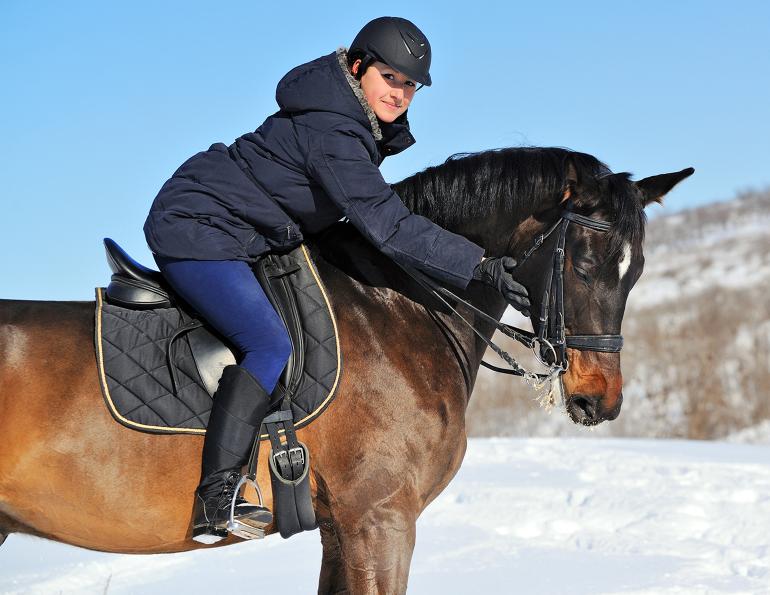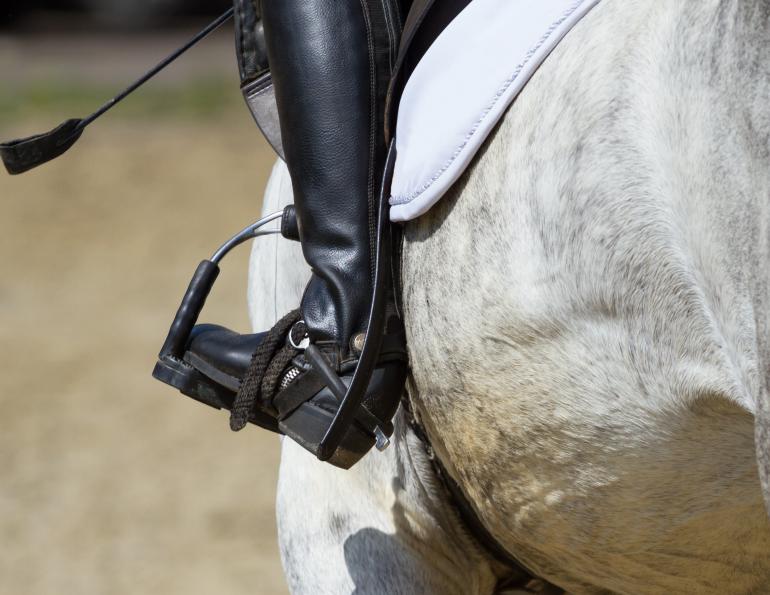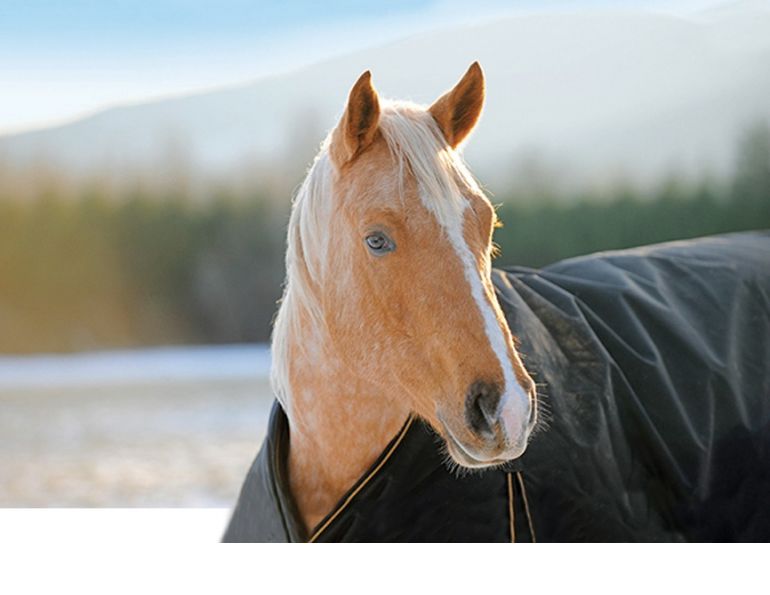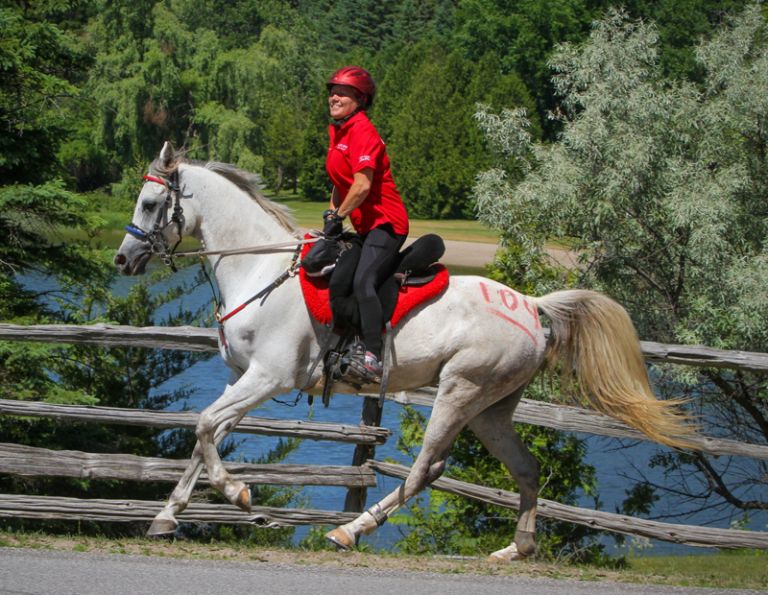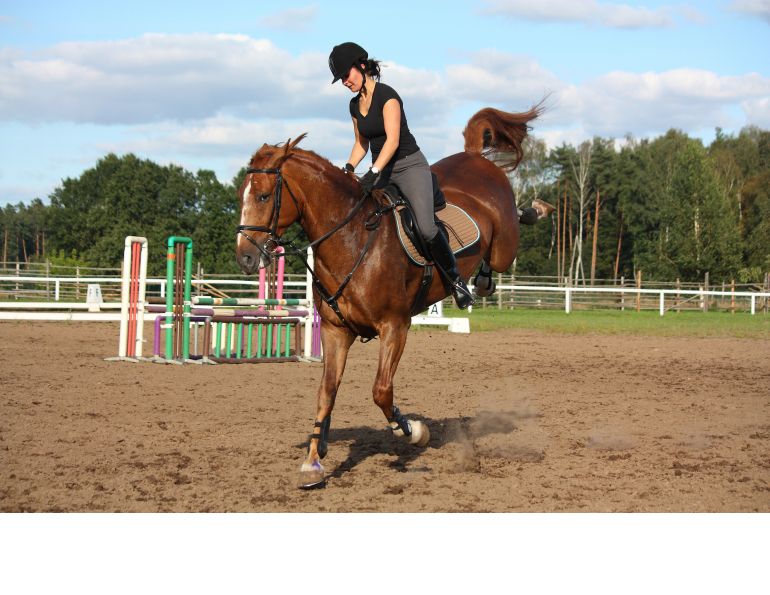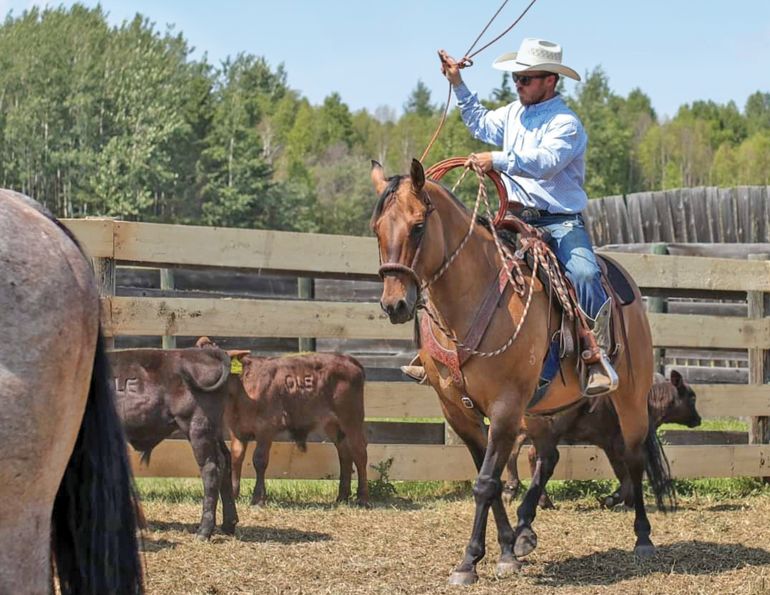By Jess Hallas-Kilcoyne
Winter is what you make it! If you’re determined not to let Old Man Winter keep you out of the saddle this season, these tips will help you and your horse enjoy those exhilarating winter rides in safety and comfort.
There is nothing quite like heading out for a hack on an invigoratingly clear winter’s day with a horse eager to power through the snow. Riding through the winter is not only fun – it benefits your equine partner by keeping him physically and mentally fit year-round.
But fresh snow and crisp air comprise just one facet of winter. Let’s not forget the misery of returning from riding through an unexpected downpour of freezing rain or driving snow with soaked-through riding gear and soggy tack, shivering from bone chilling gusts of wind.
Selecting warm, weatherproof, breathable gear for yourself and your horse is paramount to remaining comfortable and dry while riding during the cold months.

Polar fleece is an excellent wicking fabric. Simply add a weatherproof shell to stay dry and warm when riding through the rain and wind. Chaps offer additional warmth and protection from the elements. Photo: Christina Handley, www.ChristinaHandley.com.
RIDER CLOTHING & ACCESSORIES
Equestrian clothing lines are a great place to start building a winter riding wardrobe, but outdoor stores that carry clothing for skiers, mountain climbers, and snowmobilers may offer similar, more affordable options as well. If the garment wasn’t specifically designed to be worn while riding, ensure it’s safe to wear as such – no slippery, bulky, billowy, or noisy fabrics. Make sure that for your upper body you choose garments that button or zip in front, rather than those that pull off over your head, so you can peel off layers easily if you become overheated while riding.
For the rider, layering high quality garments is the key to winter riding comfort. As a general rule, your base layer should wick away sweat, the middle layer provides insulation, and the outer layer should protect you from the elements.
Base Layer
The base layer is critical because it lies directly against your skin. Choose material that is breathable and quick-drying, with good wicking (transport of moisture away from your skin to the garment’s outer surface, where it is released through evaporation).
Avoid cotton, as it absorbs moisture but will not wick, leaving you chilled, and instead consider a synthetic fabric, such as polyester or polypropylene. These provide excellent wicking and dry very quickly, although they do not provide much in the way of warmth so you may have to beef up your middle and outer layers. Certain natural fibres, such as silk or lightweight merino wool, are also good choices for base layers. Soft and anti-microbial, merino wool is an excellent wicker and dries quickly. However, even the finest wool may be irritating to sensitive skin. Silk, when treated with a wicking compound, is breathable, comfortable, and manages moisture well, though not as quickly as polyester.
Middle Layer
While its primary function is to provide warmth, the middle layer must also continue to carry moisture away from your body.
“I wear a lot of wool, and I like fleece, too,” says Wendy Nelson, a reining coach based in Cochrane, Alberta.
Mid to heavyweight wool is a popular choice as it can absorb up to 35 percent of its weight in moisture, yet keeps on insulating even when damp. As an additional bonus, wool fibres, while they absorb and release moisture, do not soak up perspiration or oils, allowing the garment to stay odour-free longer.
Fleece and other synthetics, such as Thinsulate, are more great options for your middle layer, being lightweight and breathable, and retaining their insulator properties even when wet.
Look for a jacket in a waterproof material with a high neck, vents, and fasteners at the wrist.
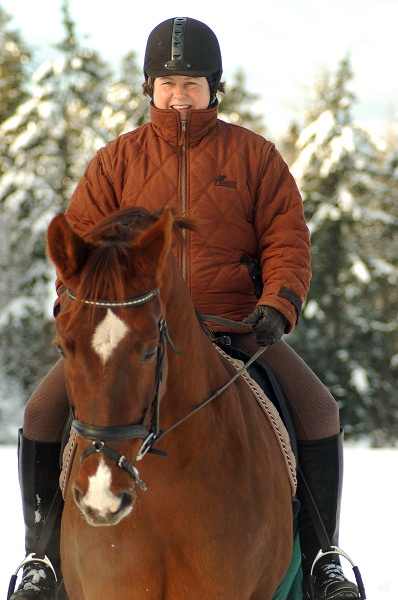
Look for a jacket in a waterproof material with a high neck, vents, and fasteners at the wrist. Photo: Darlene Brain
Outer Layer
Your choice of outer layer will depend on your climate and riding environment, so assess your needs and proceed accordingly. In milder climates, a breathable, waterproof jacket will serve you well. Colder, snowy regions require an outer layer with additional insulation, usually in the form of a removable fleece liner.
Avoid polyvinyl chloride (PVC) outer shells, as they are prone to tearing. Gore-Tex® is an excellent choice, being both breathable and waterproof, or look for hardier, tightly woven rip-stop nylon or polyester that has been factory treated with a durable water repellency (DWR) coating. Your outer layer should have fully taped seams to seal out water.
In terms of jacket design, a hood, high neck, vents, and fasteners at the wrist are all excellent features. Specialty riding jackets often include a double-vented back, back zipper, or vertical gusset that spreads open when you’re seated in the saddle – far more comfortable than a jacket that bunches up at your hips. Alternatively, a “skirted” or gusseted waterproof jacket that serves the same function may be available at outdoor or lifestyle stores. Choose one that also unzips from the bottom in front so that it fits more easily around your hips. This gusset feature doubles as a saddle cover, but in the interest of safety, make sure that your jacket will not get caught up on the saddle.
Lower Body
“It’s really important to keep the legs warm if you’re outside,” says Vibeke Coates of the Equine Association of the Yukon, who lives in Whitehorse. Thermal underwear in a synthetic, merino wool, or silk can form the base layer for your lower body underneath your regular breeches. Or, try a pair of thermal or fleece-lined breeches. To combat the brutal cold of Yukon winters, Coates actually wears her regular breeches as a base layer underneath her insulated, thermal riding pants. Chaps in leather or suede are another option to help keep you warm. Never ride in ski pants or any other pant in a slippery material.
Toasty Toes
One of the most important (and expensive) components of your winter get-up is your footwear. Fine leather boots can stretch, warp, or crack with repeated exposure to harsh winter conditions. Instead, choose one of the many specialty winter boots available which boast waterproof membranes, thick, moisture resistant soles, increased tread to prevent slips and absorb shock, and plush lining for warmth. Many of these styles can be quite bulky, so make sure before purchasing your boots that they’ll fit comfortably and safely in your stirrup with room to spare. When sizing your new boots, don’t forget that they’ll need to accommodate at least one, possibly two pairs of socks.
“You’ve got to keep your feet dry inside the boots,” says Nelson. “The key is to wear wool [socks].” As on your upper body, wearing wool on your feet will wick moisture away, keeping your toes toasty and dry. A sock with heel cushioning pads in merino wool is a smart choice, and Thinsulate™ is also a good bet for keeping toes toasty.
Frost-free Fingers
It can be difficult to find gloves that keep your hands warm without adding so much bulk that you lose much of your manual dexterity. Look for gloves with an insulating lining with an outer layer in a durable, weatherproof material that offers good grip. Leather gloves with Thinsulate™ lining are a solid option.
The wrist is a zone of high heat loss, so choose a glove with snug cuffs that are long enough to keep your wrists covered when you extend your arms.
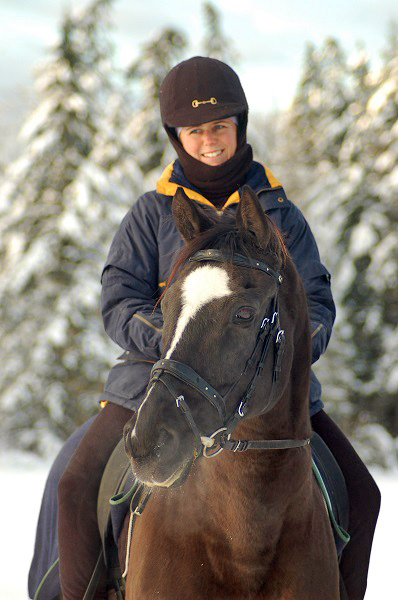
A helmet cover that extends down to protect your ears and cover your neck will help keep you warm on chilly winter days. Photo: Darlene Brain
Headgear
A scarf, neck warmer, or turtleneck can protect your neck and you can pull it up to cover your chin, mouth, and nose as needed. Additionally, a double-bonded fleece headband or balaclava worn underneath your helmet can serve to wick away sweat, protect your ears, and provide extra warmth. Some equestrian apparel companies have also designed fleece helmet covers that extend down and wrap around to cover the ears and neck.
Don’t Forget the Details
A few thoughtful extra details can also help keep you from rushing back to the house too quickly – like the small, chemical heat packs commonly found in hardware or drug stores. Some companies even manufacture these heat packs in glove and sock form. “I use them for my hands and in my boots,” says Nelson.
Having a thermos of hot coffee, tea, or cocoa handy to sip on before, during, and after your ride can help keep your core temperature up.
Safety First
When hacking out, remember to wear brightly coloured clothing or a safety vest so you’re highly visible to game hunters and vehicle traffic on short, dark winter days. Low visibility due to precipitation and reduced daylight hours can put you and your mount at risk. Several tack companies and speciality retailers manufacture reflective gear for horses as well, including quarter sheets, saddle pads, and brushing boots.
HORSE CLOTHING & GEAR
Your priority in the winter should be keeping your horse as dry as possible to keep him warm. A wet horse in cold temperatures will quickly become chilled. Other winter riding health hazards for your horse include icy ground which can cause slips and falls. By considering your horse’s comfort and safety before, during, and after a workout, you can succeed in keeping him mentally and physically fit throughout the winter.
Quarter Sheets
If you’ll be riding outdoors, Liz Ashton, of EQSport Enterprises in Victoria, BC, recommends riding with a high quality quarter sheet to keep your horse’s back and hindquarters warm and dry. Look for one that is quilted and wool or fleece-lined, for warmth, with a waterproof exterior. Some quarter sheets are meant to be worn between the saddle pad and saddle, others fit over your saddle, protecting it from precipitation. If your quarter sheet is of the former type, Ashton suggests that you think about purchasing “a really good rain cover for the saddle,” preferably in a durable, non-slip waterproof material.

A lined, waterproof quarter sheet will keep your horse’s back and hindquarters warm and dry. Photo: Darlene Brain
Tack Alternatives
You can also temporarily swap some of your good leather tack with hardier schooling equipment in water-resistant material. Ashton recommends substituting your good leather reins for rubber. “They look like regular leather reins but they’re actually all rubber,” she says.
Synthetic saddles are available in a variety of makes and styles. They are typically very affordable, easy to clean, and won’t be ruined by a little rain.
Or, do away with a saddle altogether. If you’re looking for a basic option for casual hacking, try a simple bareback pad, like the one Coates uses when temperatures drop. “It’s a lot easier, and you’re not putting a cold saddle on a horse,” she says. Plus, the act of riding bareback can keep you warm since you’ll benefit from your horse’s body heat. Bareback pads come in a variety of sizes and materials – the coziest being sheepskin. The soft natural fibres will help keep you toasty in cold weather.
If you’re more comfortable schooling in your regular saddle, you may want to consider a sheepskin saddle cover. These fuzzy covers are produced by a multitude of suppliers and are particularly beloved by endurance riders. A high quality, 100 percent wool cover will regulate your body temperature, helping to keep you warm while protecting your saddle from the elements.
Bitterly Cold Bits
Don’t forget about the little details when tacking up in the cold – like your mount’s mouth! Several new products are available to keep your horse’s bit warm electrically – or you can do it the old fashioned way. Coates keeps her bridles in the house and then carries them inside her coat to keep them warm while tacking up. Running them under warm water, if you’re lucky enough to have a hot water tank in the barn, is also effective.
Protective Legwear
When it comes to protecting your horse’s legs in cold weather, your choice of boot will depend on your exercise facilities. If you’re hacking outside, avoid fabric-based boots and leg wraps as these will only become wet and soggy. Instead, choose a sport boot made of neoprene or PVC. If you have access to an indoor arena, you can stay the course with your usual boots through the winter.
Horses shod with studs are at risk of self-harming and should be equipped with bell boots. If you hack outside, check to make sure snow has not become impacted in the gaps between the boots and your horse’s fetlocks.
Hoof Care
If you’ll be riding on icy or snowy ground, talk to your farrier about winter shoeing options.
For Ontario farrier Hans Wiza, providing a shod horse with studs can be a matter of ethics as well as a necessity for icy winters, as studs cut through frozen ground to provide stability and traction.
“I hardly ever shoe a horse that doesn’t have studs,” he says. “I’m of the opinion that the horseshoe without the appropriate traction devices is a dangerous appliance. When it comes to shoeing horses for the wintertime, there really is no substitute for the whole nine yards.”
Bear in mind that hind studs can pose a risk to your horse’s pasture companions should he kick out playfully. When hacking outdoors, compacted snow, ice, and debris can ball up, especially in shod hooves, causing instability in the fetlock joints and posing a great risk to the horse’s legs. Some of Wiza’s clients use plastic anti-snowballing, or “bubble” pads, when venturing out into the snow. If your horse is barefoot, greasing the bottom of his hooves with petroleum jelly can help prevent the snowball effect.
Even if you ride indoors, snowballs can form in the hooves during the walk from the barn to the indoor arena. Keep a hoof pick in the arena to clean out compacted snow. A quick and easy way to dislodge a snowball is to pick up the hoof and gently tap the side with a hammer – chunks of snow usually pop right out!
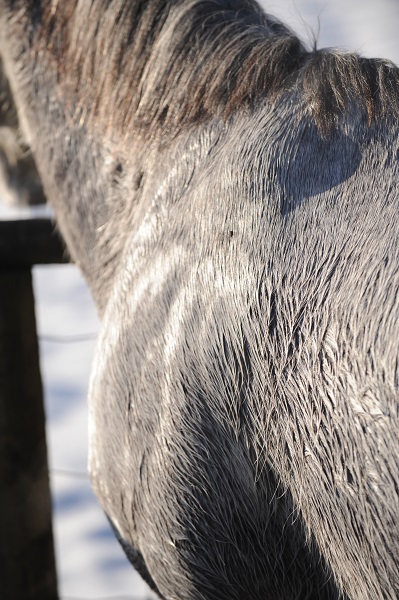
Prevent your horse from catching a chill by cooling him out properly after exercise. Cover the warm, sweaty horse with a breathable sheet or cooler and walk him until he is cool, and make sure he is thoroughly dry before he is put away or turned out. Photo: Robin Duncan Photography
Cooling Out
It is of the utmost importance that you never put your horse away when he is wet. Moisture on the horse’s skin, whether it’s from precipitation or perspiration, can lead to the horse becoming chilled. Cover your horse in a breathable sheet or cooler (wool and fleece both make excellent coolers) while you’re cooling him out at a walk. You can also throw a cooler over him while grooming, tacking up, and untacking, folding the cooler up and down his body as needed.
In a lot of cases, your choice of winter riding gear for yourself and your horse comes down to personal preference. Educate yourself about winter clothing, accessories and gear to determine what will work best for you and your equine partner, and you’re sure to have safer and more enjoyable rides all throughout the season!
Main Photo: ©Shutterstock/Pirita



